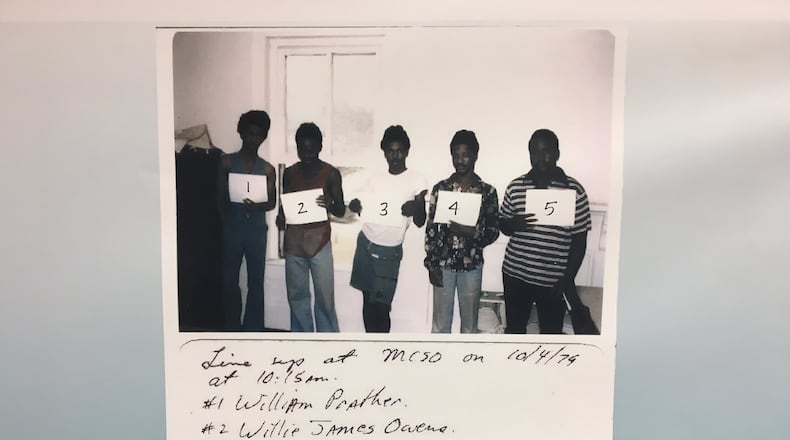This article originally ran in the AJC on Dec. 14, 2007. It was reported then by Breakdown reporter Bill Rankin, and is presented here as an illustration of how eyewitness identifications can be erroneous.
When the elderly rape victim was asked whether she saw her attacker in a lineup of five men, she picked the man in the middle — John Jerome White.
Based almost entirely on that identification, White was convicted of the 1979 attack in Meriwether County and sent to prison. But 28 years later, DNA evidence proved what White had been saying all those years: He didn't do it.
The DNA evidence did match someone else standing in that lineup in 1979. In a stunning coincidence, the man now charged with the assault — James Edward Parham — stood to White's left.
White would serve 20 years in prison for the crime now blamed on Parham. Now 54, Parham would go on to rape another Meriwether County woman six years after the attack that sent White to prison.
The fuzzy photograph of that lineup — with a slender White, in the middle wearing ragged shorts and a white T-shirt, and the stockier Parham, on the far right wearing a striped shirt and a concerned expression — was released Thursday during the final meeting of a legislative study committee considering standards for eyewitness identification procedures in Georgia.
Advocates say White's story is a vivid example of why a law is needed. Most Georgia law enforcement agencies have no written policies for collecting eyewitness identification evidence, conducting lineups and using photo arrays to identify an offender.
"The picture says it all, " said Aimee Maxwell, director of the Georgia Innocence Project, which secured White's exoneration. "Something in the way the police officers investigated this case led the victim to identify the wrong man, even though the true perpetrator was in the lineup."
In the past eight years, DNA evidence has exonerated seven Georgia men wrongly convicted of sexual assaults based on faulty eyewitness identification. About 75 percent of the more than 200 people exonerated nationwide by DNA evidence were also found guilty because of misidentification.
Parham happened to be in the Oct. 4, 1979, lineup not because he was a suspect but because he and the three other men standing alongside White were in jail at the time for unrelated offenses, Maxwell said.
"It was just a fluke [Parham] was put in the same lineup with John White, " Maxwell said. "This is a tragedy, on many levels."
White, 48, who was released from prison Monday, attended Thursday's legislative committee meeting and said he supports passage of laws setting protocols for officers to follow when gathering eyewitness identification evidence.
During a break at the Capitol, White said he met Parham again while the two served time in Macon State Prison in Oglethorpe. "He's got a cross to bear, " White said.
When he was told the rape victim identified him in October 1979, White was shocked, he said. "I felt like I was in trouble. I wondered how was I going to get out of this."
Still, White said, he had faith in the criminal justice system. "I really thought I would go home after the trial."
White, defended at the time by now-U.S. Rep. Sanford Bishop (D-Ga.), did not take the witness stand at his trial. When the jury found him guilty, White said, he told the judge he didn't do it.
"Then, when they put me back in the holding cell, I just cried, " he said.
Rep. Stephanie Stuckey Benfield (D-Atlanta) told White she will support legislation to compensate him for the time he spent wrongly incarcerated.
Benfield is also pushing legislation that would require that all photographic or physical lineups be conducted by officers who have successfully completed eyewitness ID training, beginning July 1, 2011. The bill would also require law enforcement to develop written protocols by Jan. 1, 2009.
Benfield said improved eyewitness ID procedures are necessary because there are only so many cases where DNA evidence can be used to identify the perpetrator.
The GBI supports improved eyewitness ID protocols, spokesman John Bankhead said Thursday. "Nobody in law enforcement wants to arrest the wrong person, " he said.
DNA testing was unavailable at the time of the Aug. 11, 1979, sexual assault in Meriwether County.
The 74-year-old victim, who is now deceased, was asleep on her couch when her attacker broke into her home around 4 a.m. She was raped and beaten so severely that her face was left partly paralyzed. Before her attacker left, he handed her a pillow and said, "Hold this to your face until I get out."
The woman had prescription eyeglasses, but she was not wearing them at the time, the Georgia Innocence Project's Maxwell said Thursday.
On Sept. 28, 1979, the woman was shown a number of photographs, including White's, and she said she was "almost positive" it was him. When she was presented the lineup of five men at the jail a week later, she said she was positive that White — not Parham standing just a few feet away — was the man who raped her.
The Georgia Innocence Project began investigating the case in 2004 after receiving a letter from White in prison. The project eventually learned that hairs linking White to the crime through microscopic analysis were still on file at the Meriwether County clerk's office.
In November, the hair was sent to the GBI Crime Laboratory. DNA testing determined the hair belonged to Parham, whose DNA was already in a state database, according to the GBI. Parham was arrested Tuesday and charged with rape, aggravated assault, burglary and robbery for the 1979 attack.
About the Author
The Latest
Featured



